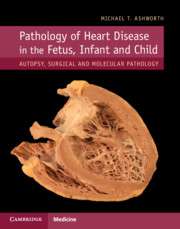Book contents
- Pathology of Heart Disease in the Fetus, Infant and Child
- Pathology of Heart Disease in the Fetus, Infant and Child
- Copyright page
- Dedication
- Contents
- Preface
- Chapter 1 The Anatomy of the Normal Heart
- Chapter 2 Examination of the Heart
- Chapter 3 Development of the Heart
- Chapter 4 Congenital Heart Disease (I)
- Chapter 5 Congenital Heart Disease (II)
- Chapter 6 Ischaemia and Infarction
- Chapter 7 Cardiomyopathy
- Chapter 8 Inflammation of the Myocardium, Endocardium and Aorta
- Chapter 9 The Coronary Arteries
- Chapter 10 Metabolic and Storage Disease
- Chapter 11 Pericardium
- Chapter 12 Fetal Cardiovascular Disease
- Chapter 13 Tumours
- Chapter 14 Heart Transplantation
- Chapter 15 Sudden Cardiac Death in the Young
- Index
- References
Chapter 5 - Congenital Heart Disease (II)
Published online by Cambridge University Press: 19 August 2019
- Pathology of Heart Disease in the Fetus, Infant and Child
- Pathology of Heart Disease in the Fetus, Infant and Child
- Copyright page
- Dedication
- Contents
- Preface
- Chapter 1 The Anatomy of the Normal Heart
- Chapter 2 Examination of the Heart
- Chapter 3 Development of the Heart
- Chapter 4 Congenital Heart Disease (I)
- Chapter 5 Congenital Heart Disease (II)
- Chapter 6 Ischaemia and Infarction
- Chapter 7 Cardiomyopathy
- Chapter 8 Inflammation of the Myocardium, Endocardium and Aorta
- Chapter 9 The Coronary Arteries
- Chapter 10 Metabolic and Storage Disease
- Chapter 11 Pericardium
- Chapter 12 Fetal Cardiovascular Disease
- Chapter 13 Tumours
- Chapter 14 Heart Transplantation
- Chapter 15 Sudden Cardiac Death in the Young
- Index
- References
Summary
The second of the two chapters on congenital heart disease deals with the less common conditions. Conditions covered include double-inlet ventricle, double-outlet ventricle, atrial isomerism and Ebstein's anomaly. The conditions are well illustrated. A section follows on the pathological features of pulmonary arterial hypertension in congenital heart disease. A large section is devoted to common surgical operations for congenital heart disease that may be encountered by the pathologist, and a section is devoted to the pathological assessment of the operated heart with congenital heart disease.
Keywords
- Type
- Chapter
- Information
- Pathology of Heart Disease in the Fetus, Infant and ChildAutopsy, Surgical and Molecular Pathology, pp. 118 - 154Publisher: Cambridge University PressPrint publication year: 2019



